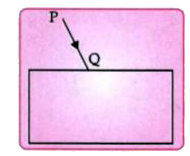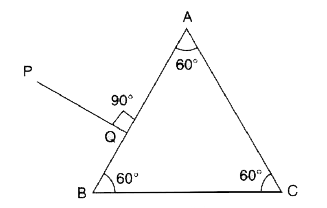In the diagram below PQ is a ray of light incident on a rectangular glass block.i Copy the diagram and complete the path of the ray of light through the glass block. In your diagram mark the angle of incidence by letter i and the angle of emergence by the letter e .ii How are the angles i and e related to each other?
ii When the incident ray is undergoing minimum deviation the angle of incidence is equal to angle of emergence i.e. ∠i = ∠e.
Related Solutions
In the diagram below, PQ is a ray of light incident on a rectangular glass block.

Copy the diagram and complete the path of the ray of light through the glass block. In your diagram, mark the angle of incidence by letter 'i' and the angle of emergence by the letter 'e'.
View SolutionIn the diagram below, PQ is a ray of light incident on a rectangular glass block. How are the angles i and 'e' related to each other?
View SolutionIn the adjacent diagram, AO is a ray of light incident on a rectangular glass slab. (a) Complete the path of the ray till it emerges out of the slab. (b) In the diagram, mark the angle of incidence (i) and the angle of refraction (r) at the first interface. how is the refractive index of glass related to the angles i and r ? (c) Mark angle of emergence by the letter e. how are the angles i and e related ? (d) Which two rays are parallel to each other ? Name them (e) Indicate in the diagram the lateral displacement between the emergent ray and the incident ray. state one factor that affects the lateral displacement.
View SolutionIn an experiment to trace the path of a ray of light passing through a rectangular glass slab, four students measured the angles of incidence (i), angles of refraction (r) and angles of emergence (e) as shown in the diagrams :

The correct measurement is given in the diagram :
View SolutionWith a neat labeeled diagram, prove that if the angle of incidence and angle of emergence of a light ray falling on a glass slab are I and e respectively, then i=e.
View SolutionIn the experiment on tracing the path of a ray of light passing through a rectangular glass slab, the correct setting of the protractor (D), for measuring the angle of incidence (), and the angle of emergence () correspond, respectively, to diagrams :

View SolutionA ray of light strikes the surface of a rectangular glass slab such that the angle of incidence in air is (i) 0^(@), (ii)45^(@) . In each case, draw a diagram to show the path taken by the ray as it passes through the glass slab and emerges from it.
View SolutionDraw diagrams to show the refraction of light from (i) air to glass, and (ii) glass to air. In each diagram, label the incident ray, refracted ray, the angle of incidence (i) and the angle of refraction (r).
View SolutionA ray of light falls normally on the surface of a transparent glass slab. Draw a ray diagram to show its path and also mark angle of incidence and angle of emergence.
View SolutionThe following diagram shows a glass prism of critical angle . Copy the diagram and complete the path of incident ray AB emerging out of the prism marking the angle of incidence on each surface.

View SolutionIf the angle incidence and angle of emergence of a light ray falling on a glass slab are i and e respectively, then prove that, i=e.
View SolutionIf the angle of incidence and angle of emergence of a light ray falling on a glass slab are I and e respectively, prove that,i=e.
View SolutionIf the angle of incidence and angle of emergence of a light ray falling on a glass slab are i and e respectively, then prove that i=e.
View SolutionIf the angle of incidence and angle of emergence of a light ray falling on a glass slab are i and e respectively, prove that, i = e.
View SolutionAfter tracing the path of a ray of light through a glass prism, a student marked the angle of indicence (angle i) , angle of emergence (angle e) and the angle of deviation (angleD) as shown in the diagram. The correctly marked angles are :
View Solution
Copy the diagram given below and complete the path of the light ray till it emerges out of the prism. The critical angle of glass is . In your diagram mark the angles wherever necessary.
View SolutionIn the figure PQ is a ray Incident on a prism ABC. Complete the ray diagram showing the passage of light. Mark angle of incidence i, angle of emer gence e, angle of deviation and angle of re fractions and

View SolutionA ray of light PQ is incident normally on the hypotenuse of a right angled prism ABC as shown in the diagram given below:
Copy the diagram and complete the path of the ray PQ till it emerges from the prism.
View SolutionDraw a neat and labelled diagram to show the path of a ray of light in air and glass when the ray is incident obliqely on a glass slab. Show the (i) incident ray (ii) refracted ray (iii) emergent ray (iv) angle of incidence (v ) angle of refraction (vi) angle of emergence in the diagram.
OR
Draw a neat and labelled diagram to show refraction of light through a glass slab.
View SolutionIn an experiment, the path of a ray of light passing through a rectangular glass slab was traced by a student. Which of the following diagram shows correct measurement of angle of incidence (i), refraction (r ), and emergence (e ) ?

View Solution